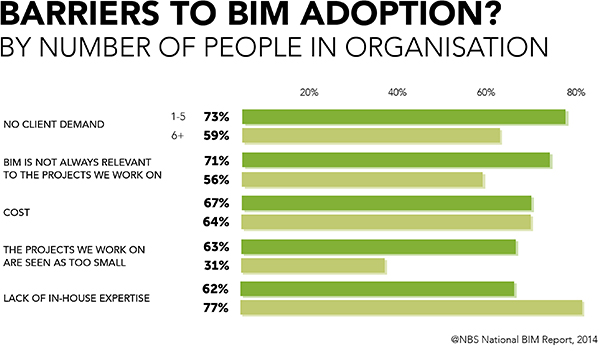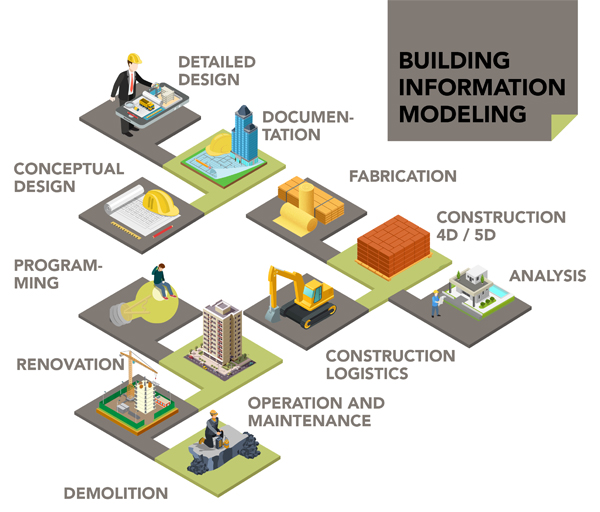
Successful BIM Adoption for Architects
Architects face many challenges in the modern world. Advances in technology have opened up new horizons for architectural design, but on the flipside have created an almost continuous state of flux in which architects are required to learn and implement new techniques regularly.
Before we take a look at Building Information Modelling or BIM adoption and some advice on how to undertake it successfully, let’s first examine the reasons behind the changes in the industry and why BIM implementation is so important for architects.
The Changing Requirements and Complexity of Construction Projects
Too much change is the mortal enemy of successful architectural design. Maybe that’s just a tiny bit over-dramatic, but there’s no doubt that changes to a project can cause major headaches for the architect.
Maybe the stakeholders want the size of the project downsized, perhaps the site survey missed some vital details that need accounting for, or maybe the function of the building is to be changed. Whatever the reason for the change, one thing is for sure – it will usually have a knock-on effect on the design.
So, how does all this change affect architects?
Design variations can be a real challenge for architects. Even minor changes can make life difficult for the architect, as modern construction projects are highly interconnected and complex undertakings.
In his seminal 1996 book on project complexity, K Gidado points to several reasons for the increased complexity.
-
01
Modern projects have many different interconnected systems and interfaces between the various elements
-
02
There are often high levels of intricacy which require clear details on how to execute the construction and assemble structural features
-
03
Projects often undergo several revisions at the construction stage, requiring excellent communication between designers and construction contractors
The last of these is the crucial point for architects. These days, it is rare for a construction project to continue to completion without any design revisions.
The Need Around BIM
BIM is the process by which a complete and accurate 3D model of a building project is constructed in specialist software such as Autodesk Revit.
The BIM model contains information on all the elements of the architectural and structural design, as well as electrical and plumbing services. It is this level of detail, and the ability to build and easily amend an interconnected design, that makes it ideal for mitigating the problems caused by change and revisions.
BIM has many other benefits. It has been shown to:
-
01
Improve productivity and reduce the time taken to create and edit designs
-
02
cut costs across the Architecture, Engineering, and Construction (AEC) industry. For instance, a public sector building project in the UK resulted in an estimated 4% reduction in cost, equating to over £2 million.
-
03
Increase collaboration – the detailed 3D models become a shared resource that can be used by all interested parties to make important decisions about the project and amend design elements to suit. 70% of architects noticed improved project outcomes from the collaborative effect of BIM.
-
04
Increase project flexibility, counteracting the complexity and revision requirements of modern projects
BIM Adoption Around the World
BIM is being adopted as an AEC industry standard worldwide.
-
 United KingdomThe UK is leading the way with a clear national strategy for implementation which is shown in the high adoption rate – 54% of projects using BIM in 2016. The UK government have been instrumental in driving this adoption, saving £855 million on existing projects in the year 2014/15.
United KingdomThe UK is leading the way with a clear national strategy for implementation which is shown in the high adoption rate – 54% of projects using BIM in 2016. The UK government have been instrumental in driving this adoption, saving £855 million on existing projects in the year 2014/15. -
 USAbiggest single market with annual revenue of $1.07 billion. This has led to a great deal of technological innovation, and current BIM software is more powerful than ever, but there is still a way to go to achieve high adoption rates.
USAbiggest single market with annual revenue of $1.07 billion. This has led to a great deal of technological innovation, and current BIM software is more powerful than ever, but there is still a way to go to achieve high adoption rates. -
 CanadaBIM users increased from 64% in 2013 to 67% in 2016
CanadaBIM users increased from 64% in 2013 to 67% in 2016 -
 EuropeA market size of $2.7 bn in 2016 and growing at 23.4% CAGR.
EuropeA market size of $2.7 bn in 2016 and growing at 23.4% CAGR. -
 Globallyoverall global demand is high, estimated at $3.52 bn in 2016 and projected to exceed $10 bn by 2022.
Globallyoverall global demand is high, estimated at $3.52 bn in 2016 and projected to exceed $10 bn by 2022.
Projected growth of the global BIM market

Current BIM Adoption Level of Industries
AEC industries in most countries have been quick to realize the need for BIM adoption, due to the following recent trends within the building industry:

Sustainabilty

Material life cycle assessment

Higher building standards

More robust building management systems

Improves risk analysis

Integrated design approach
However, this recognition of the need hasn’t necessarily led to speedy adoption. A 2017 survey in Jordan indicated that only a small proportion of contractors are on board with BIM, with only 53% of professionals in the AEC industry having a basic understanding of it.
AEC businesses that want to thrive over the coming years should be looking to adopt and implement BIM with a degree of urgency, to benefit from the numerous advantages.
The Challenges of BIM Implementation for Architects
Although we’ve established that there is a very real need for BIM adoption in the architecture and building trade, there are some challenges that face individuals and companies willing to implement it.
This section will highlight the challenges and pitfalls of BIM installation before looking at ways to overcome them.
People and Training Needs
Implementing any new strategy or initiative requires a certain amount of time for people to acquire the requisite knowledge and skills. BIM is no exception. In fact, creating and manipulating BIM 3D models is a complex task that requires IT skills, problem-solving, engineering knowledge, communication skills and creativity, amongst others.
When these training needs are combined with the time taken to prepare the technological infrastructure, install and test the software, it’s clear to see that BIM implementation can be a time-consuming process.
A Salford University research paper on the subject highlighted the following difficulties with implementing BIM in architectural practice:
BIM Standards and Standard Object Dictionaries
Countries that have high rates of BIM adoption are the ones that have introduced national standards and guidelines as part of an overall strategy. The main reason is that the absence of an agreed set of standards makes it impossible for people to transfer, export and share BIM designs and data. Countries such as UK, Finland, Singapore, and Norway have successfully developed and implemented national standards.
Also, BIM design relies on the creation of objects which are components of a build, that is structural elements such as columns and beams, or utilities such as plumbing, electrical components, etc. To make BIM models interchangeable between different parties and contractors, it is advisable to have consistent objects. Thus, many countries have implemented, or are in the process of developing, standard object dictionaries which set out the properties of common objects.
Some countries face difficulties in establishing national standards and objects. For instance, the USA has some government agencies and private companies that have already designed and are using their own BIM standards. To reign these in and get everyone to adopt universal standards will be almost impossible unless there is pressure from the top.
Contractual Matters and BIM
Contracts and working agreements hold complex projects together, especially when there are many different contractors and sub-contractors involved. The BIM model can be viewed as intellectual property, and therefore details such as ownership, confidentiality and fair usage should be agreed upon when drawing up a contract. The final agreement should state whether the BIM model itself should be considered a contract document.
If BIM issues are neglected during the writing up of the contract, it is likely that there will be disputes later on. If this situation arises, it can jeopardize the success of the overall project or at least slow progress. From the architect’s point of view, it’s best if the BIM model is considered to be a contractual document that can be shared openly with all parties.
Different Levels of Adoption
As an example, there are four main recognized levels of BIM adoption in the UK, each differing in the amount that BIM is utilized within an organization or industry.




There are additional unofficial BIM levels that are recognized by many in the industry known as 4D, 5D and 6D BIM which describe the use of BIM for time analysis, cost management, and facilities management respectively.
The main challenge in rising through these levels lies in moving from level 1 to level 2 and getting disciplines to collaborate. If the architects are the only party actively using BIM, the full benefits will not be realized.
Concerns Over the Process of BIM Implementation
With any change comes uncertainty. Often, this will lead to resistance to change or a complete rejection of new methods. To overcome the uncertainty and concerns that architects may have, it’s useful to identify the steps involved in achieving implementation and how to carry them out successfully.
Other Challenges Preventing Widespread BIM Adoption
Some other challenges that are either slowing down or preventing BIM adoption are as follows.

A challenge that is often cited is the lack of communication between different companies within the construction industry. In many countries, an adversarial, hyper-competitive culture exists, rather than the collaborative approach needed for successful BIM implementation.
Other real (or perceived) challenges include:
Lack of client demand
73% of small architectural or construction companies (with five or fewer employees) state that there is little to no demand for BIM from clients. In some countries such as the UK public projects are required to use BIM, but many clients are not aware of or see the potential benefits.
Perceived lack of applicability
71% of SMEs is under the misconception that BIM isn’t appropriate for their projects. For instance, companies that are involved in residential construction may think that their operations aren’t complex enough to warrant using it. However, BIM can certainly help to improve efficiency and streamline workflows for domestic buildings.
Prohibitive costs
There are substantial costs to consider, including the purchase of expensive software, training and time spent. A simple cost-benefit comparison will show that the long-term gains will far exceed the short-term outlay.
Skills shortage
77% of construction companies and 62% of SME contractors revealed that they didn’t think they had the in-house BIM skills available to implement it well. To counteract this argument, there is a wide-range of training courses available to suit all skill levels and competencies, and now is also a good time to recruit people with the requisite skills before demand gets too high.
Hardware demands
Installing the powerful BIM software often requires an upgrade to the existing network. This incurs disruption and has cost implications.
Technology Concerns
It was always a challenge to adopt new technology over the legacy systems without delay regarding the transition phase. However, BIM comes not only with the technical view of implementation but also considers the project background in the form of the socio-cultural situation that sets the base for BIM implementation.

The Demand for Specialist Skills
Using BIM software can be a complex process at first, especially without adequate training. The following is a breakdown of some specific benefits of using BIM and the skills required to achieve them.
-
All project data and information accessible from one place
Importing 3D scans, digital elevations, aerial imagery, and geometry, including all of the survey information in the BIM model means that everything is stored in one accessible location and can be viewed and used by various parties more easily than paper print-outs. Basic IT skills are the only requirement for this part of the process.
01 -
Faster 3D design and project planning
BIM drawing tools are faster than its 2D CAD counterparts. Objects are connected directly to databases to allow automatic counting of components and quick quantity takeoffs. The skills required to achieve this are design skills, engineering knowledge, and advanced IT skills.
02 -
Improved collaboration
The sharing of BIM models between different companies and disciplines makes the overall project run far more smoothly from start to finish. Design reviews and checks can be carried out quickly and remotely. The skills needed are good communication, management and problem-solving.
03 -
Simulation and visualization
Things such as sunlight and shadows can be modeled and simulated in the BIM software. The analysis and optimization can be carried out automatically in the software. Skills needed are design and IT proficiency.
04 -
Resolving conflicts
Clash detection of services and structural elements prevents large additional costs being accrued, by discovering them early rather than on site. This requires design, IT and engineering skills.
05 -
Setting out work sequence
The BIM model and associated information and drawings can be used to optimize the sequence and order of activities. Resources and staff can be scheduled in at the most convenient points during construction, informed by the BIM model. This requires construction and engineering knowledge, management skills and IT skills.
06 -
Present designs clearly and thoroughly in 3D
The BIM model is perfect for showcasing or demonstrating the scope of the project and features to clients, investors, politicians, etc. This requires presentation, IT and communication skills.
07
The BIM model is perfect for showcasing or demonstrating the scope of the project and features to clients, investors, politicians, etc. This requires presentation, IT and communication skills.
Data Security Concerns

Data is used and analyzed at various stages of the construction process, and it’s crucial the integrity and accuracy of the data are secured throughout. For instance, once the building is completed, the as-built information will be gathered and the BIM model updated to suit. If the BIM data is going to continue to be used once the building is in use, then it is even more important that this happens. Changes to building materials and resources need to be captured, and any sections that deviated from the original design need to be modified on the BIM model.
As there are large amounts of data and information stored within the BIM model, ensuring data integrity and security can be a challenge.
The responsibility for this task lies with the operational information manager, who oversees the management, cyber-security and control and maintenance of the data. They make sure that any changes that occur over the life of the building need to be updated in the BIM model quickly.
considerations
BIM typically requires new software and regularly requires new or upgraded hardware to run the processing intensive software.
Case Studies – BIM Adoption by Businesses
Hong Kong Highway Department Cut Costs by 12% on Zhuhai to Macao Bridge
The Leighton – Chun Wo Joint Venture won the $4.6bn to design and build the 40 000 sq meter passenger clearance building and surrounding works, a large part of the overall $10.6bn sea crossing project.

Leighton Asia used BIM technology throughout the project leading to several benefits:
- Cost savings of 12% on overall construction and 15% of the survey budget
- Increased collaboration between the eight main contractors, two consultants, and many subcontractors, reducing the complexity of managing the project
- Models and 2D drawings from 8 contractors all merged into one 3D BIM model
- Final as-builts carried out using point clouds imported to the BIM model, thus streamlining the process and saving 15% of the expected survey budget
- Problems rectified early on using BIM tech, such as the discrepancies with the unusual wavy roof design
- Simulating the workflow using BIM highlighted and prevented safety issues.
KAFD Metro Station in Saudi Arabian Capital Riyadh Uses BIM to Reduce Complexity
The 45 000 square meter metro station in Riyadh’s financial district is a transport hub for six new metro lines, with six platforms, and two floors of underground car parking. With a high degree of complexity, the main contractor ZHA decided to create a 3D BIM model using customized plug-ins.

- Creating bespoke BIM plug-ins reduced complexity, making the project easier to design and manage
- Saved time and money on site, as well as in the design process
- Clash detection rectified problems early on, to zero clashes with a +/- 0.1mm tolerance
- 4D and 5D BIM is being used to order and schedule work processes and manage resources efficiently.
London Curved Tower Made Possible by BIM
1 Merchant Square, London is a tower block of such complexity that it’s hard to imagine it being possible without BIM technology. The curved structure posed many challenges for designers and building contractors, that BIM helped to overcome.

- BIM computational modeling helped to design the complex trapezoidal cladding
- BIM objects such as 2000 doors were created that could be customized for uniqueness, yet still, reduce the complexity of the design
- Construction problems minimized by running isolated clash detection, such as architectural walls compared with cable trays.
- Precision design and data analysis led to a successful project, cost savings and increased productivity.
It’s Time to Embrace BIM
With countries such as USA, Singapore, UK, and other European and Asian countries leading the way, people in the construction industry are becoming increasingly aware of the vast benefits to be gained from implementing BIM or outsourcing it to experts.
Architects and designers will benefit considerably from increased BIM use. Redesigns and modifications will become easier and faster, especially at BIM levels of 3 and higher. Overall, BIM use leads to cost savings, increased productivity and efficiency and safer working practices. Now is the time to adopt BIM into your business to offer your clients a world-class service.
– IndiaCADworks
















